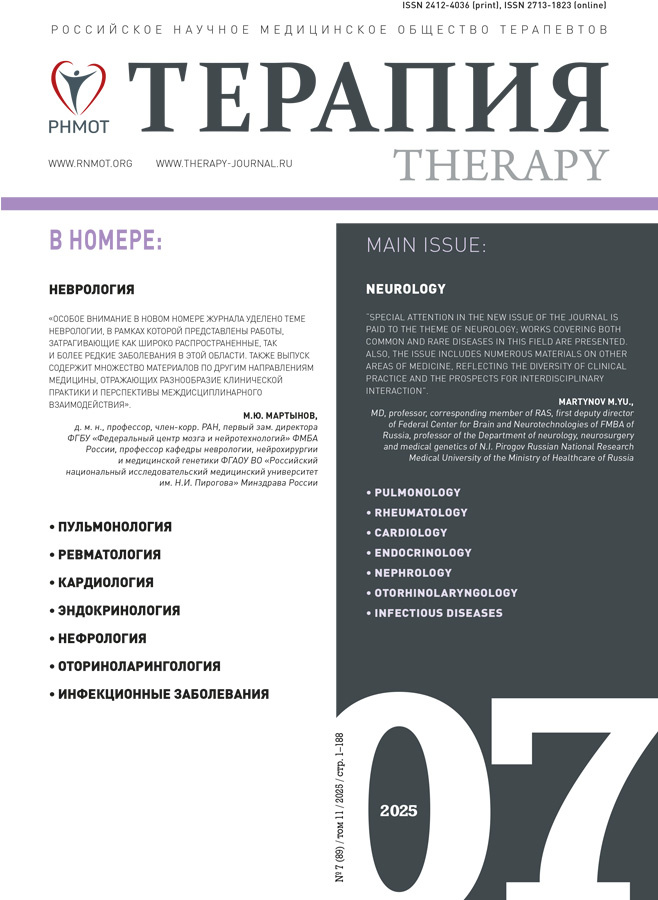Phenotyping of patients with arterial hypertension based on the renal filtration function and arterial stiffness using cluster analysis
- Авторлар: Kuchin K.V.1, Butusov M.V.1, Klemenov A.V.1
-
Мекемелер:
- Privolzhsky Research Medical University of the Ministry of Healthcare of Russia
- Шығарылым: Том 11, № 7 (2025)
- Беттер: 46-57
- Бөлім: ORIGINAL STUDIES
- ##submission.datePublished##: 24.10.2025
- URL: https://journals.eco-vector.com/2412-4036/article/view/694112
- DOI: https://doi.org/10.18565/therapy.2025.7.46-57
- ID: 694112
Дәйексөз келтіру
Аннотация
Arterial hypertension (AH) and chronic kidney disease (CKD) mutually aggravate each other, forming a cardiorenal continuum with a high risk of complications. Study of their correlation through the prism of arterial stiffness is relevant for stratifying such kind of patients and optimizing their therapy.
The aim of the research is phenotyping patients with AH basing on the condition of renal filtration function and elastic properties of arterial wall using cluster analysis (CA) and determination of the clinical features of identified phenotypes.
Material and methods. A sample of 203 patients with stable AH aged 50.5 ± 6.9 years underwent CA on two input parameters: glomerular filtration rate and pulse arterial pressure.
Results. Three phenotypes of AH were identified: 1st – preserved renal filtration function and arterial elasticity, 2nd – reduced renal filtration function and arterial elasticity, 3rd – impaired renal filtration function and preserved arterial elasticity. The 2nd phenotype of patients was characterized by the most unfavorable clinical profile.
Conclusion. Performed CA allowed us to identify three clinically significant phenotypes of AH. The combination of reduced renal filtration function and increased arterial stiffness is associated with the maximum cardiovascular risk.
Толық мәтін
Авторлар туралы
Kirill Kuchin
Privolzhsky Research Medical University of the Ministry of Healthcare of Russia
Email: kuchinkv@ya.ru
ORCID iD: 0009-0008-6619-1539
MD, PhD (Medicine), associate professor, associate professor of the Department of internal medicine
Ресей, Nizhny NovgorodMikhail Butusov
Privolzhsky Research Medical University of the Ministry of Healthcare of Russia
Email: misha21082@rambler.ru
ORCID iD: 0009-0002-0742-014X
MD, postgraduate student of the Department of internal medicine
Ресей, Nizhny NovgorodAlexey Klemenov
Privolzhsky Research Medical University of the Ministry of Healthcare of Russia
Хат алмасуға жауапты Автор.
Email: klemenov_av@list.ru
ORCID iD: 0000-0002-3403-0713
SPIN-код: 1559-4472
MD, Dr. Sci. (Medicine), associate professor, professor of the Department of internal medicine
Ресей, Nizhny NovgorodӘдебиет тізімі
- McCallum W, Testani JM. Updates in cardiorenal syndrome. Med Clin North Am. 2023;107(4):763–80. PMID: 37258013. PMCID: PMC10756136. https://doi.org/10.1016/j.mcna.2023.03.011
- Young JB, Eknoyan G. Cardiorenal syndrome: An evolutionary appraisal. Circ Heart Fail. 2024;17(6):e011510. PMID: 38757274. https://doi.org/10.1161/circheartfailure.123.011510
- Gallo G, Lanza O, Savoia C. New Insight in cardiorenal syndrome: From biomarkers to therapy. Int J Mol Sci. 2023;24(6):5089. PMID: 36982164. PMCID: PMC10049666. https://doi.org/10.3390/ijms24065089
- Spineli LM, Pandis N. Meta-analysis of cluster-randomized trials. Am J Orthod Dentofacial Orthop. 2023;163(2):288–91. PMID: 36710062. https://doi.org/10.1016/j.ajodo.2022.11.003
- Ilgen U. Cluster analysis as a clinical and research tool in Behcet’s syndrome. Curr Opin Rheumatol. 2024;36(1):3–8. PMID: 37729051. https://doi.org/10.1097/bor.0000000000000980
- Casanova S, Ahmed E, Bourdin A. Definition, phenotyping of severe asthma, including cluster analysis. Adv Exp Med Biol. 2023;1426:239–52. PMID: 37464124. https://doi.org/10.1007/978-3-031-32259-4_11
- Zarei D, Saghazadeh A, Rezaei N. Subtyping irritable bowel syndrome using cluster analysis: A systematic review. BMC Bioinformatics. 2023;24(1):478. PMID: 38102564. PMCID: PMC10724977. https://doi.org/10.1186/s12859-023-05567-8
- Gianlorenço AC, Costa V, Fabris-Moraes W, Menacho M, Alves LG, Martinez-Magallanes D, Fregni F. Cluster analysis in fibromyalgia: A systematic review. Rheumatol Int. 2024;44(11):2389–402. PMID: 38748219. https://doi.org/10.1007/s00296-024-05616-2
- Кобалава Ж.Д., Конради А.О., Недогода С.В., Шляхто Е.В., Арутюнов Г.П., Баранова Е.И. с соавт. Артериальная гипертензия у взрослых. Клинические рекомендации 2024. Российский кардиологический журнал. 2024; 29(9): 230–329. [Kobalava ZhD, Konradi AO, Nedogoda SV, Shlyakhto EV, Arutynov GP, Baranova EI et al. Arterial hypertension in adults. Clinical guidelines 2024. Rossiyskiy kardiologicheskiy zhurnal = Russian Journal of Cardiology. 2024; 29(9): 230–329 (In Russ.)]. EDN: GUEWLU. https://doi.org/10.15829/1560-4071-2024-6117
Қосымша файлдар











